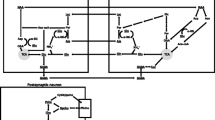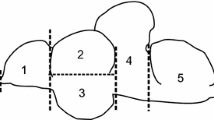Abstract
Acclimation of goldfish at 35°C increased the cerebellar content of aspartate, glutamate, and taurine and [3H]glutamate uptake. Acclimation at 4°C increased the levels of glutamine, serine, and alanine and glutamine synthetase (GS) activity. Adenosine content increased in cerebellum of fish acclimated to warm temperature. K+-evoked release of endogenous and exogenous glutamate from cerebellar slices increased in fish acclimated at 35°C compared to 4°C. The basal level of cyclic adenosine 3′:5′-monophosphate (cAMP) in perfused cerebellar slices in fish acclimated at 35°C was much higher than in fish acclimated at 5° and 22°C. It is concluded that variations of environmental temperature produces large neurochemical changes in goldfish cerebellum.
Similar content being viewed by others
REFERENCES
Fry, F. E. J. 1971. The effect of environmental factors on the physiology of fish. Pages 1–98, in Hoar, W. S. and Randall, D. J. (eds.), Fish physiology 4, Environmental relations and behavior, Academic Press, New York.
Shaklee, J. B., Christiansen, J. A., Sidell, B. D., Prosser, C. L., and Whitt, G. S. 1977. Molecular aspects of temperature acclimation in fish: contributions of changes in enzyme activities and isozyme patterns to metabolic reorganisation in the green sunfish. J. Exp. Zool. 201:1–20.
Hilbig, R., Rahmann, H., and Rosner, H. 1979. Brain gangliosides and temperature adaptation in eury-and stenothermic teleost fish (carp and rainbow trout). J. Therm. Biol. 4:29–34.
Greer, G. L., and Gardner, D. R. 1974. Characterization of responses from temperature-sensitive units in trout brain. Comp. Biochem. Physiol. 48A:189–203.
Nelson, D. O., and Prosser, C. L. 1981. The role of nervous system in temperature adaptation of poikilotherms. Ann. Rev. Physiol. 43:281–300.
Driedzic, W., Selivonchick, D. P., and Roots, B. I. 1976. Alk-l-enyl ether-containing lipids of goldfish (Carassius auratus L.): brain and temperature acclimation. Comp. Biochem. Physiol. 53B:311–314.
Cossins, A. R. 1977. Adaptation of biological membranes to temperature. Effect of temperature acclimation of goldfish upon the viscosity of synaptosomal membranes. Biochem. Biophys. Acta 470:395–411.
Peterson, R. H., and Prosser, C. L. 1972. The effects of cooling on responses of goldfish central nervous system. Comp. Biochem. Physiol. 42:1019–1037.
Harper, A. A., Watt, P. W., Hancock, N. A., and Macdonald, A. G. 1990. Temperature acclimation effects on carp nerve: a comparison of nerve conduction, membrane fluidity and lipid composition. J. exp. Biol. 154:305–320.
Matheson, D. F., and Roots, B. I. 1988. Effect of acclimation temperature on the axon and fiber diameter spectra and thickness of myelin of fibers of the optic nerve of goldfish. Exp. Neurol. 101:29–40.
Hebb, C., Stephens, T. C., and Smith, M. W. 1972. Effect of environmental temperature on the kinetic properties of goldfish brain choline acetyltransferase. Biochem. J. 129:1013–1021.
Baslow, M. H. 1967. Temperature adaptation and the central nervous system of fish. Pages 205–226, in Prosser, C. L. (ed), Molecular mechanisms of temperature adaptation, AAAS Publ. 84.
Sebert, P., Barthelemy, L., and Caroff, J. 1985. Serotonin levels in fish brain: effects of hydrostatic pressure and water temperature. Experientia 41:1429–1430.
Crawshaw, L. I. 1979. Responses to rapid temperature change in vertebrate ectotherms. Am. Zool. 19:225–237.
Friedlander, M. J., Kotchabhakdi, N., and Prosser, C. L. 1976. Effects of cold and heat on behavior and cerebellar function in goldfish. J. Comp. Physiol. 112:19–45.
Kotchabhakdi, N. 1976. Functional circuitry of the goldfish cerebellum. J. Comp. Physiol. 112:47–73.
Foster, A. C., and Roberts, P. J. 1980. Endogenous amino acid release from rat cerebellum in vitro. J. Neurochem. 35(2):517–519.
Sandoval, M. E., and Cotman, C. W. 1978. Evaluation of glutamate as a neurotransmitter of cerebellar parallel fibers. Neuroscience 3:199–206.
Levi, G., Gordon, R. D., Gallo, V., Wilkin, G. P., and Balazs, R. 1982. Putative amino acid transmitters in the cerebellum. I. depolarization-induced release. Brain Res. 239:425–445.
McGeer, P. L., Eccles, J. C., and McGeer, E. 1978. Anatomical distribution of GABA pathways in brain. Pages 202–209, in Molecular neurobiology of the mammalian brain, Plenum Press, New York.
Villani, L., Migani, P., Poli, A., Niso, R., and Contestabile, A. 1982. Neurotoxic effect of kainic acid on ultrastructure and GABAergic parameters in the goldfish cerebellum. Neuroscience 7:2515–2524.
Lucchi, R., Poli, A., Traversa, U., and Barnabei, O. 1994. Functional adenosine Al receptors in goldfish brain: regional distribution and inhibition of K+-evoked glutamate release from cerebellar slices. Neuroscience 58:237–243.
Hill, D. W., Walters, F. H., Wilson, T. D., and Stuart, J. D. 1979. High performance liquid chromatographic determination of amino acid in the picomole range. Analyt. Chem. 51:1338–1341.
Cunha, R. A., and Sebastião, A. N. 1993. Separation of adenosine triphosphate and its degradation products in innervated muscle of the frog by reverse phase high-performance liquid chromatography. Chromatographia 28(No 11/12):610–612.
Lowry, O. H., Rosenbroug, N. J., Farr, A. L., and Randall, R. J. 1951. Protein measurement with the Folin phenol reagent. J. Biol. Chem. 193:265–275.
Poli, A., Lucchi, R., Gandolfi, O. and Barnabei, O. 1992. Spontaneous recovery of MPTP-damaged catecholamine systems in goldfish brain areas. Brain Research 585:128–134.
Contestabile, A., Munarini, A., Bissoli, R., Chiodini, O., and Villani, L. 1986. Modification of ultrastructural and neurochemical parameters in synaptosomes of the retino-deprived goldfish optic tectum. Exp. Brain Res. 62:560–566.
Patel, A. J., Hunt, A., and Tahourdin, C. S. M. 1983. Regional development of glutamine synthetase activity in rat brain and its association with the differentiation of astrocytes. Dev. Brain Res. 8:31–37.
Atkinson, D. E. 1968. The energy charge of the adenylate pool as a regulatory parameter. Interaction with feedback modifiers. Biochemistry 7:4030–4034.
Brown, B. L., Ekins, R. P., and Albano, J. D. M. 1972. Saturation assay for cyclic AMP using endogenous binding protein. Adv. Cyclic Nucleotide Res. 2:25–40.
Daly, J. W., Padgett, W., and Seamon, K. B. 1982. Activation of cyclic AMP-generating systems in brain membranes and slices by the diterpene forskolin: augmentation of receptor-mediated responses. J. Neurochem. 38:532–544.
Barbeau, A., Inoue, N., Tsukada, Y., and Butterworth, R. F. 1975. Minireview: The neuropharmacology of taurine. Life Sci. 17:669–678.
Okamoto, K., Kimura, H., and Sakai, Y. 1983. Evidence for taurine as an inhibitory neurotransmitter in cerebellar stellate interneurons: selective antagonism by TAG (6-aminomethyl-3-methyl-4H, 1,2,4-benzothiadiazine-1, 1 dioxide). Brain Res. 265:163–168.
Okamoto, K., and Sakai, Y. 1981. Inhibitory actions of taurocyamine, hypotaurine, homotaurine, taurine and GABA on spike discharges of Purkinje cells, and localization of sensitive sites, in guinea-pig cerebellar slices. Brain Research 206:371–386.
McGeer, P. L., and McGeer, E. G. 1989. Amino acid neurotransmitters. Pages 311–332, in Basic Neurochemistry: Molecular, Cellular and Medical Aspects, 4th edn, New York: Raven Press.
Chan-Palay, V., Palay, S. L., and Wu, J. Y. 1979. Gamma-aminobutyric acid pathways in the cerebellum studied by retrograde and anterograde transport of glutamic acid decarboxylase antibody after in vivo injections. Anat. Embryol. 157:1–14.
Storm-Mathisen, J. 1976. Distribution of the components of the GABA system in neuronal tissues, cerebellum and hippocampus-effects of axotomy. Pages 148–168, in Roberts, E., Chase, T. N. and Tower, D. B. (eds), GABA in Nervous tissue function, Raven Press, New York.
Lajtha, A., and Sershen, H. 1975. Changes in the rates of protein synthesis in the brain of goldfish at various temperatures. Life Sciences 17:1861–1868.
Weil-Malherbe, H. and Gordon, G. 1971. Amino acid metabolism and ammonia formation in brain slices. J. Neurochem. 18:1659–1672.
Cooper, A. J. L., Mora, S. N., Cruz, N. F., and Gelbard, A. S. 1985. Cerebral ammonia metabolism in hyperammonemic rats. J. Neurochem. 44:1716–1723.
Cooper, A. J. L., and Plum, F. 1987. Biochemistry and physiology of brain ammonia. Physiol. Rev. 67, 440–519.
Goldberg, A. M., and McCaman, R. E. 1967. A quantitative microchemical study of choline acetyltransferase and acetylcholinesterase in the cerebellum of several species. Life Sci. 6:1493–1500.
Vizi, S. E., and Palkovits, M. 1978. Acetylcholine content in different regions of the rat brain. Brain Res. Bull 3:93–96.
Kan, K. S. K., Chao, L. P., and Eng, L. F. 1978. Immunohistochemical localization of choline acetyltransferase in rabbit spinal cord and cerebellum. Brain Res. 146:221–229.
Finger, T. E. 1978. Cerebellar afferents in teleost catfish (Ictaluridae). J. comp. Neurol. 181:173–182.
Burke, S. P., and Nadler, J. V. 1988. Regulation of glutamate and aspartate release from slices of the hippocampal CA1 area: effects of adenosine and baclofen. J. Neurochem. 51:1541–1551.
Phillis, J. W., Walter, G. A., and Simpson, R. E. 1991. Brain adenosine and transmitter amino acid release from the ischemic rat cerebral cortex: effects of the adenosine deaminase inhibitor deoxycoformycin. J. Neurochem. 56:644–650.
Schmidt, M. J., Thomberry, J. F., and Molloy, B. B. 1977. Effects of kainate and other glutamate analogues on cyclic nucleotide accumulation in slices of rat cerebellum. Brain Research 121:182–189.
Author information
Authors and Affiliations
Rights and permissions
About this article
Cite this article
Poli, A., Notari, S., Virgili, M. et al. Neurochemical Changes in Cerebellum of Goldfish Exposed to Various Temperatures. Neurochem Res 22, 141–149 (1997). https://doi.org/10.1023/A:1027307305595
Issue Date:
DOI: https://doi.org/10.1023/A:1027307305595




